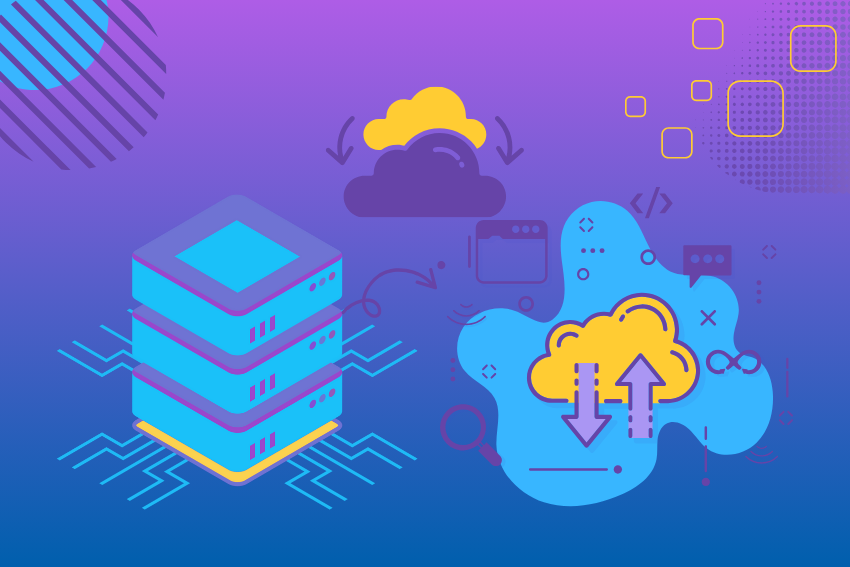Cloud migration means transferring data, applications or other business infrastructures from on-site servers to a cloud setup. In order to be flexible, scale and run operations efficiently, companies now rely on cloud migration to improve their technology. The process helps companies save money by reducing hardware and upkeep costs, handle changes more easily and access advanced tools and services available through the cloud.

To move to the cloud, companies must first evaluate their current set-up, decide on the right provider and make data transmission secure. Cloud migration can be done through rehosting, replatforming, refactoring and retargeting and each of these methods has its own benefits depending on your company’s needs.
On the other hand, moving to the Cloud can cause risks such as security issues for data, challenges with compliance and interruptions of services during the process. For organizations to manage their cloud migration project successfully, it is vital to understand these elements.
This article looks at what cloud migration is, its benefits, step-by-step process, types of migration strategies, the related risks and challenges.
What is Cloud Migration?
Cloud migration means moving data, applications or other infrastructures of a business from the company’s on-site system to the cloud. Some of the methods in this transition are “lift and shift,” which involves little adjustment and “refactoring,” which means redesigning apps to exploit the advantages of the cloud.
The reason for moving to the cloud is mainly to get increased scalability, more flexibility and lower costs, as the cloud usually delivers these features better than on-premises solutions. Using the cloud allows employees to work together better and come up with innovative ideas more easily by using sophisticated services immediately.
To migrate to the cloud, it is necessary to plan, evaluate the situation, move the infrastructure, test everything and keep optimizing. At this step, organizations understand what they want to achieve with the migration and how it will work, by paying attention to compliance, security and business continuity.
The process continues with an assessment to see whether the IT infrastructure is ready to use cloud services safely. When you migrate using the migration phase, you move data and applications to the cloud by choosing strategies like staged, total transfer all at once or a mix of both.
After the migration is finished, tests are carried out to check that all systems work as intended and then steps are taken to increase both efficiency and lower expenses. For a cloud migration to succeed, it needs to be organized and carried out right to avoid risks and make sure the process meets the company’s aims.
Benefits of Cloud Migration
Moving to cloud solutions is proven to be a major turning point for businesses of all types. Relocating company data, applications and business parts to the cloud gives companies the opportunity to enjoy several benefits.
Cost Efficiency
The opportunity to save a lot of money is one of the main reasons many organizations move to the cloud. It is necessary to spend large amounts of money on hardware, software and maintenance for on-premises IT systems. Businesses using cloud services only need to pay for what they actually need, making it possible to use as little or as much as you like. This means businesses do not need to make major investments and cut down on expenses related to keeping things operating.
Scaling and Flexibility
Because clouds are very scalable, businesses can quickly add or remove resources based on their requirements. It is possible for companies to add more servers quickly when demand is high and use fewer servers during slack periods. As a result of this elasticity, businesses do not have to worry about being limited by hardware when things change in the market.
Teamwork and Productivity
Moving to the cloud brings about better chances for teams to collaborate, with team members working from both close and distant locations. Real-time collaboration and editing on documents are now possible time efficiency and less waiting time in comparison to using older file-sharing platforms. Such teamwork boosts productivity and makes the workplace more active and adaptable.
Disaster Recovery and Business Continuity
Having their data lost or unavailable can seriously harm any business. Many cloud vendors ensure their clients’ data is protected by backing up and allowing for fast recovery when something breaks. With this, businesses become more continuous and have a lower chance of losing data, so they can quickly resume work after facing any challenge.
Access to New Technologies
Cloud migration allows companies to access technologies they might not be able to use on their own due to their cost or difficulty. Some of them are artificial intelligence (AI), machine learning (ML), big data analytics and Internet of Things (IoT) solutions. With the help of cloud-based systems, firms can adopt these technologies, leading to more innovation and a top position in the market.
Enhanced Security
Despite some people’s opinions, implementing cloud services usually provides better security than before the move. Well-known cloud providers dedicate resources to keeping data safe by encryption, setting up detection systems and meeting all required industry rules. With these providers, businesses can enjoy high-level security strategies and experts who may be out of reach for them.
Environmental Impact
Migrating to the cloud helps to reduce the carbon released by having separate data centers. Cloud service companies usually build big, efficient data centers that help them use fewer resources. Moving to the cloud helps save the environment and also cuts companies’ energy bills.
Effective Business Operations
When a company uses the cloud, it can spend less time on IT management and concentrate on its main business aims. Teams in the IT department can concentrate on boosting the business and developing innovative solutions instead of supporting hardware and networks. This change helps organizations get maximum effectiveness from their operations and tie IT to what the business wants to achieve.
The Cloud Migration Process
Cloud migration can really help businesses, but they need to plan and carry out the move diligently. Let’s explore the cloud migration process, talking about the important stages and key recommendations.
Planning and Assessing
- Define Objectives: The process should start with setting straightforward migration goals. Whether the company is seeking lower expenses, greater flexibility or improved handling of disasters, having firm goals will oversee all the decisions.
- Review Current Infrastructure: Take the time to investigate every aspect of your current technology system. It’s important to identify the applications, workloads, required dependencies and data during this step. Cloud readiness assessments can give you useful information.
- Pick Cloud Model: Choose between the public, private or hybrid cloud model depending on what you need. Think about issues such as security, meeting compliance needs and the cost before making a decision.
- Choose Cloud Service: Assess the options for cloud service providers by checking their services, how dependable they are, the level of support they provide and their pricing. AWS, Microsoft Azure and Google Cloud Platform are commonly used because they all have their own benefits.
Strategy Development
Implement Your Migration:
Some of the techniques for moving to the cloud involve:
- Through rehosting (Lift and Shift), companies can move their applications to the cloud with not a lot of changes.
- Re-architecting parts of the applications to get the most from cloud capabilities.
- By Replatforming, you update a few parts to utilize cloud-native benefits.
- Deleting old applications’ files to getting rid of unused applications.
- Retaining some workloads using local resources.
Create a Plan
Produce a detailed schedule that covers when the migration will take place, the resources needed and its goals and achievements. Managing both risk and complexity should be done in different phases.
Handling Risk
Find out about possible risks and make a plan to manage them. Issues that could arise are data being lost, security gaps and periods when the network is not available.
Migration Execution
- Follow Rules and Regulations: Install all the necessary cloud systems, covering networks, storage and security. Follow the company’s rules and obey the regulations that apply to your work.
- Move Applications and Data: The first steps should be to migrate less important workloads so you can adjust and perfect your technique. Get help from the tools developed by cloud vendors or from external companies to make migration easier.
Trials and tests should be performed to make sure the model works.
Be sure to test all the applications and migrated data after moving to the cloud. Check that the development is meeting standards for function, performance and security.
Best Practices and Decision Making
- Optimize Performance: Make use of cloud-native technologies to maximize your application’s performance and its cost-efficiency. This might mean instances are scaled automatically, load balancing is used and managed solutions are applied.
- Implement Governance: Put in place standards to guide how cloud resources are governed. You should monitor how cloud services are used, keep an eye on spending and guarantee they follow the rules.
Factors need to be improved continuously to ensure the program is not outdated.
Movement to the cloud is not something that only happens once. Keep an eye on what’s happening in the economy and make changes when required.
Training and Change Management
- Train Staff: Offer appropriate training to IT team members and those who use technology to ensure they are properly skilled in utilizing these services.
- Manage Change: Address the cultural changes by applying change management strategies so everyone in the organization can transition easily.
Types of Cloud Migration
Cloud migration strategies, often referred to as the “6 Rs,” define how applications and workloads are transitioned to the cloud. Each strategy varies in complexity, cost, and impact:
Rehost (Lift and Shift)
Easily the most basic cloud migration technique is rehosting which is sometimes called ‘Lift and Shift.’ It refers to relocating applications or projects to the cloud, keeping their design mostly unchanged. It is the right choice for companies who want to move servers fast and without interruption. Although rehosting is easy and fast, it may not use all the special cloud-native tools, making it more expensive later.
Replatform (Lift, Tinker, and Shift)
Replatforming is the act of making small changes to the application or workload so it works efficiently in the cloud. The strategy of “Lift, Tinker and Shift” tries to strike the middle ground between simplicity and effort to be better. When you make use of cloud-specific features like managed databases or serverless architectures, replatforming helps your company work more efficiently and spend less, still having a fast migration schedule.
Refactor (Re-architect)
Refactoring which involves changing the design of applications, offers the most comprehensive approach to moving to the cloud. Applications are improved by putting microservices, containerization and serverless computing to their intended use in the cloud. Although scalability, performance and cost savings are most likely with such an approach, it needs a big investment of effort and money. Firms should look at the advantages and costs of making a change, including how complicated it might be and the amount of money it will take.
Repurchase
Cloud applications are chosen to replace the older options used by the company. This way, companies do not have to maintain IT systems themselves which becomes unnecessary when choosing Software as a Service (SaaS). Repurchasing may make it possible to cut down on overhead right away, but may also require paying extra costs at the start and examining each vendor closely.
Retire
Part of migrating is to stop running all unnecessary applications and retain only the required ones. It makes sense to use this approach for traditional applications that are either redundant or moving them is a struggle. When organizations retire old systems, they can make their operations easier and put more effort into important projects.
Retain
In retaining, businesses use selected applications locally or partly remote after having migrated other workloads to the cloud. It is a good approach when the regulations, performance standards or security needed are hard to satisfy within a cloud environment. Through retaining, organizations can govern their important systems and still get the benefits that the cloud offers.
Risks and Challenges of Cloud Migration
While cloud migration offers significant benefits, it also comes with potential risks that organizations must address:
Data Security and Compliance
Ensuring the safety of data and that it fulfills all needed legal rules is one of the main challenges in cloud migration. It is important for organizations to install strong protective measures and prefer cloud providers that offer complete certification on compliance requirements. Not dealing with these concerns may result in data breaches and facing legal troubles.
Downtime and Business Disruption
If the migration to the cloud is not done and planned correctly, it may result in downtime and affect the business. In order to limit the effect on their activities, organizations should set up a detailed migration plan with steps for testing, rolling it out in stages and having contingency arrangements.
Cost Overruns
Although cloud migration is expected to cut costs after some time, it might initially bring about unplanned expenses for the organization. It may happen if the actual costs for resources, data transfer or migrating are higher than expected. Good management of costs requires complete analysis and budget plans.
Vendor Lock-In
When you depend mainly on one cloud provider, you are more likely to be locked into using it, because changing to another provider is hard and pricey. It is advisable for organizations to turn to multi-cloud strategies or use open standards to keep their flexibility and prevent relying on only a single supplier.
Skill Gaps
Since cloud migration involves working with specific cloud services, it needs highly skilled people. The IT teams in organizations may lack certain skills and in these cases, extra training or the recruitment of new personnel may become necessary. You can help reduce this gap by offering extra learning to employees or by working with people who are experts in cloud solutions.
Data Loss or Corruption
While migrating, there is a chance that data may be lost or altered in a way that greatly affects a business’s operations. It is necessary to protect the data by backing it up and validating it during the entire migration.
Conclusion
Cloud migration helps companies make their IT systems more efficient, save on expenses and improve how fast they respond to needs. If businesses pay attention to the planning stage, pick the right approach and consider possible dangers, they can enjoy what cloud computing offers. Businesses must plan their move to the cloud so that it helps them reach their long-term objectives. User should always seek out best practices and current trends related to cloud adoption to fully benefit from migrating.


